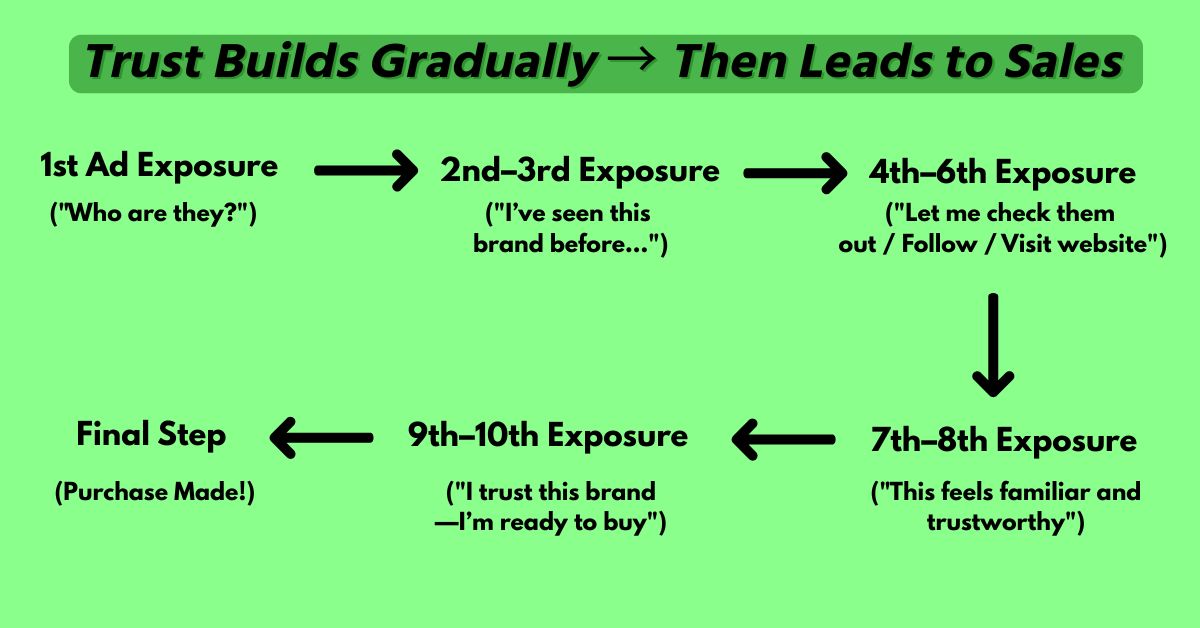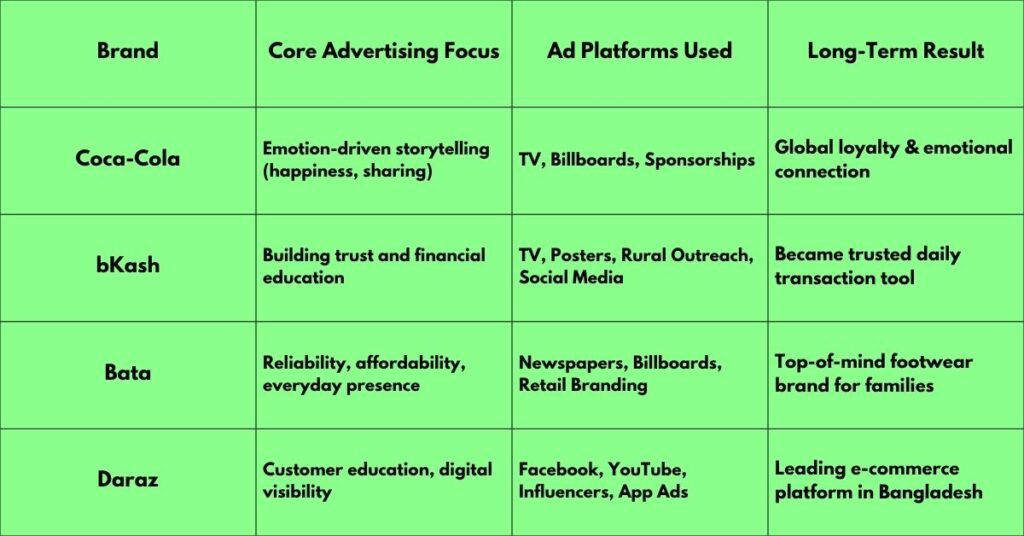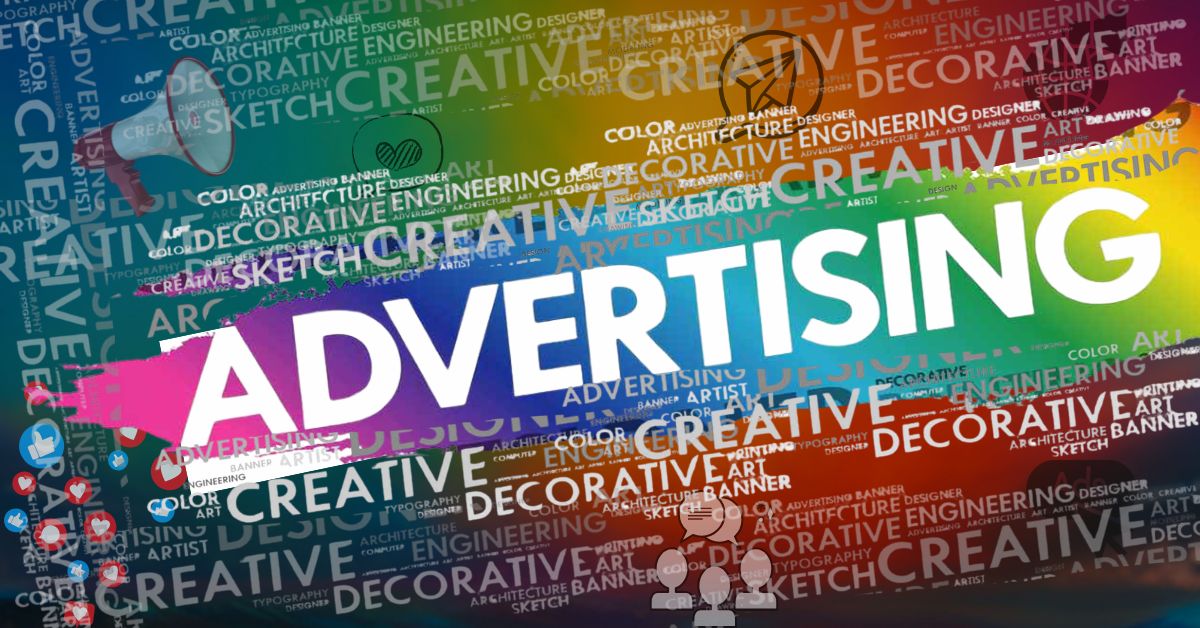1. Introduction
Advertisement or ad, is a form of communication used to promote a product, service, brand, or idea to a target audience. Mainly it designed to inform, attract attention, build awareness, and ideally to encourage action, such as making a purchase. Through advertising, they helps to raise awareness, generate interest, and persuade consumers to choose a particular product, service, or brand. Sometimes it showcase the benefits, features, and value of the advertised item. Advertisers carefully consider their target audience when crafting messages and choosing media channels. Advertising is directly tied to the expectation of quick sales, as they thing run an ad, and customers will immediately start buying.
It’s a natural impulse to want to see a direct return on investment, where money spent on promotion translates almost instantly into money earned in sales. The impact of advertising isn’t always direct or immediately, but the process is, it works slowly, building trust, shaping brand image, and influencing decisions that may happen weeks, months even Yearly. According to studies, 96% of visitors to a business website are not ready to buy during their first visit. That means all visitors are not ready to buy stuffs but they are watching, remembering and forming options. Whenever they start trusting on your website by seeing that there have something different from other products, they will start buying.
As a human being, everyone wants unique things or products, so if we talk today’s competitive world, where attention is currency and trust takes time to build, the true power of advertising lies in its long-term influence, not just in short-term results. Narrow perspective overlooks a profound and often more powerful truth about the nature of effective advertising.
2.Busting the Myth: “No Sales Means Ads Failed”
The statement “No sales means ads failed” is a myth. Many people, especially business owners and marketers new to advertising, believe in a simple (but wrong) idea, “If an ad doesn’t bring sales right away, it’s a failure.” In reality, just because you didn’t get a sale today doesn’t mean your ad didn’t work. It might be working in ways you can’t see yet. Successful advertising campaigns often involve more than just driving immediate sales.
Advertising can be a long-term investment. It can take time for a potential customer to move through the sales funnel and make a purchase. Even if sales aren’t directly driven by an ad, it can still contribute to other areas of the business. For example, a strong ad campaign can improve brand recognition, which can lead to more sales in the long run.
2.1.Advertising Does More Than Sell
Advertising can drive immediate purchases, but that’s just one part of the story. Ads also,
•Create awareness
•Introduce your brand to new audiences
•Remind old customers you still exist
•Build trust and credibility
•Educate people about your product or service
2.2. Customers Need Time
People don’t always buy the first time they see something. Think about your own experience:
•You see a product online
•You check the price but wait for your salary
•You want to read reviews first
•You save it in your cart and forget
•You come back a week later and finally buy
2.3. Measuring Only Sales is Short-Term Thinking
Relying only on sales to judge your ad’s success is like judging a movie by its first 5 minutes. You miss the bigger story.
•Digital tools now allow us to measure:
•Reach how many people saw the ad
•Engagement who liked, shared, or commented
•Click-throughs who visited your site or app
•Conversions later who came back to buy in a few days
3.Reasons Why Advertisement May Not Bring Immediate Sales
Advertising may not always bring immediate sales due to several factors, such as taking time for consumers to process information, build trust and also taking decision to make a purchase. But if we see the reality consumer behavior doesn’t always follow this process and that’s another major reason why it take times because not the ad has failed, but customers are human, and humans need time to decide. Advertising’s effect on sales can be spread out over time because many customer aren’t in the market for a product or service at the exact moment they see an ad.
3.1.Understanding the Customer’s Mindset
For selling products its mandatory to understand customer’s mindset. To truly understand why advertising may not lead to immediate sales, we must first step into the shoes of the customer. Advertising is not just about pushing a product, it’s about reaching people at the right time, in the right way, with the right message. As each customer has their own process for making a purchase and it might take just a few minutes to decide.
Understanding the customer mindset also important because a person might not be ready today, but that doesn’t mean they never will be. That’s why never stop advertising as the more they see your brand, the more familiar and trustworthy it becomes. In fact, research shows that repeated exposure builds comfort, and comfort leads to trust. Customers don’t buy with logic, they buy with emotion first, and logic later. So for sales, it may not show immediate sale but it can by following those, spark curiosity, evoke a feeling (happiness, trust, inspiration), create connection with a message or value. This will effect buyers mind and when they purchase they will recall the brand or product.
In today’s digital world, the average customer is more informed and cautious than ever. With endless options at their fingertips, they take their time to decide. They start searching about the brand or the product through read reviews and blog posts, watch YouTube comparisons, ask for opinions on social media, sign up for newsletters to track discounts, follow brands without buying. So, create effective advertising, businesses need to respect the customer’s mindset because every person is not ready to buy now but late may they will buy.
3.2.The Buyer’s Journey: A Step-by-Step
The buyer’s journey describes the process that the customer goes through, from the moment they first hear about a product or brand to the time they finally make a purchase decision. Customers often multi-stage expedition before committing to a product or service. Understanding this journey is not an academic but it is fundamental for advertisers. Because it instructed what information a customer needs, when they need it, and how they prefer to receive it.
•Stage 1: Awareness
The very first stage is awareness, means a person realizes they have a need or becomes aware of a solution they didn’t even know existed. Their mindset is one of discovery, curiosity, and sometimes, mild frustration or a nascent longing. As an ad might come on their Facebook feed, play during a YouTube video, or appear on a billboard on the way to work. It might feature a product, service, or idea that catches their eye but they are not ready to buy yet but now, they know your brand exists. Goals of this stage are spark interest, catch attention introduce your brand or product clearly and memorably.
•Stage 2: Consideration
After awareness customer know about the brand or product, now they enter in research phase where they begin comparing features, checking reviews, visiting your website, watching videos, asking friends for opinions, or reading blog posts. Through all those they just want to make sure themselves that they are choosing a right product or band. This stage is important because customers are gathering information that will help them trust your brand, even though they might not buy anything right now. Goals of this stage are, educate, remind, highlight your product’s benefits, features, and value compared to others.
•Stage 3: Decision
This is the last and final stage where the customer is ready to make a decision. Their mindset is focused on validation, final details, and overcoming any last-minute hesitations. If your advertising has been consistent, helpful, and trustworthy throughout the journey, there’s a high chance the customer will pick your product. Advertisements here are designed to convert. They provide the final nudge, eliminate friction, and facilitate the transaction. Need to focus on direct calls to action, pricing, discounts, unique selling propositions (USPs), guarantees, customer service, ease of purchase. Goals of this stage are, encourage action, offer a clear call-to-action like “Buy now,” “Order today,” or “Limited time offer” and reinforce all the reasons why your product is the right choice.

Photo: Stage of The Buyer’s Journey
3.3.Why Immediate Sales Aren’t a Reliable Measure
Among small or new companies, it’s common to expect that once you launch an advertisement, customers will immediately rush to buy your product. Particularly one focused on building brand awareness or fostering consideration, is designed to move a customer along the journey, not necessarily to finalize a sale. Many basic analytics systems attribute sales to the very last touchpoint a customer interacted with before purchasing. Modern purchases are rarely the result of a single ad and they are often influenced by numerous “touchpoints” across various channels over weeks or months. This “last-click bias” completely ignores all the previous ads that played a critical role in bringing the customer to that final decision.
Read More: Akij Group: Pan-China Collaboration Begins with MoU to Broaden Business Horizon
Effective brand-building advertising can create a “halo effect” where a positive perception of the brand enhances the effectiveness of all subsequent marketing efforts, including direct-response ads. For products or services that represent a significant investment the sales cycle can span months or even years. If a customer already trusts and likes a brand due to its long-term advertising, they are far more likely to respond positively to a sales promotion.
4.Advertising Build Brand Awareness
In this digital world everyone have lots of choices and advertisement plays a significant role. Brand Awareness helps a company’s target audience become familiar with its products or services and differentiate them from competitors. When an ad doesn’t lead to an immediate sale, it still leaves behind something extremely valuable, a mental impression.
In a world filled with endless choices and constant noise, brand awareness acts like a guiding light. This fundamental prerequisite is achieved through brand awareness, and its primary engine is advertising. In a world filled with endless choices and constant noise but when when they will related something with the ad, people are finally ready to make a decision, your brand is the first one they think of.
4.1. What is Brand Awareness?
Brand awareness refers to the level of familiarity consumers have with a particular brand. It’s not just about whether they’ve seen your logo, it’s about whether they can recall your brand when they need something you offer. We can describe brand awareness with two key dimensions, one Brand Recognition and another is Brand Recall.
Brand recognition means the ability of consumers to identify a brand when they encounter it through seeing a logo, a specific color scheme, a packaging design, or a distinctive jingle and immediately linking it back to a particular company or product demonstrates strong brand recognition. It’s a key component of brand awareness and essentially measures how well a brand is remembered and recognized by its target audience.
Strong brand recognition helps build trust, loyalty, and can be a significant factor in purchasing decisions. On the other hand, brand recall, also known as unaided brand awareness, is the ability of consumers to remember a brand when prompted with a product category without any hints. This is often referred to as “top-of-mind awareness” and is a powerful indicator of a brand’s salience in the consumer’s mind. It often categorized into unaided and aided recall. Strong brand recall is crucial for businesses because it directly impacts purchasing decisions.
When a brand is easily recalled, it’s more likely to be considered by the consumer when they’re ready to buy. Businesses can measure brand recall through surveys, asking consumers to name brands associated with a specific product category. Several factors can influence brand recall, as advertising, social media presence, customer service, and overall customer experience. Effective branding strategies play a significant role in building strong brand recall. Consistent branding helps create a memorable association between the brand and its products or services.
4.2.Why Brand Awareness Comes Before Sales
Brand awareness is generally considered a prerequisite for sales, it establishes a foundation of familiarity and trust with potential customers. Before anyone can buy from you, they need to know you exist. No matter how great your product is, people won’t buy it if they’ve never heard of it. Brand awareness is the first step in the buying process. It ensures that when consumers are ready to make a purchase, they are aware of your brand and its offerings. When consumers are familiar with a brand, they are more likely to choose it over an unfamiliar one, even if the unfamiliar brand offers a similar product or service.
Consistent exposure and positive interactions with a brand can lead to increased trust and loyalty. When customers feel a connection to a brand, they are more likely to make repeat purchases and recommend the brand to others. A strong brand awareness campaign can make other marketing efforts more effective. By following this strategies several known companies like Coca-cola, Pepsi, bKash continuously create advertisings because they ensuing that people don’t forget them when the time comes to choose.
4.3.How Advertising Builds Awareness
Advertising builds awareness by exposing a large number of people to a brand or product, making it more recognizable and memorable. The more someone sees your brand in different places and formats as, TV, social media, posters, websites which will make it more familiar.
•Increasing Visibility and Reach: Advertising, especially when strategically placed, can reach vast audiences across various platforms. This exposure helps a brand become more visible and familiar to potential customers.
•Creating Recognition and Recall: Consistent messaging, slogans, and visual elements across different ad campaigns help solidify a brand’s identity in the minds of consumers.
•Building Trust and Credibility: By consistently delivering a positive brand experience, advertising can build trust and credibility with consumers. Features, quality, and positive emotional associations conveyed through advertising can influence perceptions and create a positive brand image.
•Influencing Purchase Decisions: Awareness is the first step towards a purchase. When consumers are familiar with a brand and have a positive perception of it, they are more likely to consider it when making a purchase. Advertising can also highlight a product’s benefits and persuade potential customers to try it.
•Utilizing Different Advertising Channels: Paid search campaigns can help capture attention and connect with people based on their interests. Social media platforms offer opportunities to connect with younger audiences and create engaging content. Targeted advertising can be used to reach specific demographics and interests. Even non-intrusive native advertising can effectively reach relevant audiences.
•Emotional Connection: Advertising can tap into emotions and create a deeper connection between consumers and a brand. Commercials that tell emotional stories can make the brand more memorable and relatable.
4.4.Tools That Support Brand Awareness
After creating a brand or product if you don’t spread about it, then how can you grab any customer. So tools like, TV Commercials, Social Media Ads, Billboards, Radio Advertising, play a significant role specially in this generation where everything is online based. If people start recognizing your brand more often, talking about it, or even searching for it online, then your advertising is working.

Photo: Tools That Support Brand Awareness
5.Trust and Familiarity: Invisible Impact of Gaining Customer Trust Over Time
For selling a product or recognized as a familiar brand to customer is vital and advertising help it to promote. If customer don’t know about the product then how can they porches those products and grow their trust upon the bard. It is earned gradually, through repetition, consistency, and presence. Even if a customer doesn’t click “Buy Now” the first time they see your ad, that doesn’t mean the ad was wasted. While immediate sales capture attention, a profound and often invisible impact of advertising lies in its remarkable ability to cultivate this trust and foster a sense of familiarity.
5.1.Why Seeing a Brand Often Builds Trust
Seeing a brand repeatedly fosters trust through familiarity, often called the mere exposure effect. When a brand consistently appears in various contexts (like social media, packaging, and advertisements), it becomes recognizable and, subsequently, more trustworthy. Repeated exposure to a brand’s logo, colors, and messaging makes it more easily recognizable and memorable.
Consumers are more likely to choose brands they recognize and associate with positive experiences, as they perceive less risk in selecting a familiar option. Repeated interactions with a brand, especially positive ones, build positive associations and brand equity, leading to greater customer loyalty. According to Litmus Branding Pvt, When a brand effectively communicates its values and mission, it can resonate with consumers on an emotional level, fostering deeper trust and loyalty.
Read More: How RFL Group Revolutionized Industrial Growth and Local Manufacturing in Bangladesh?
5.2. Familiar Brands Feel Safer
Familiar brands feel safer because of a combination of psychological and practical factors. This familiarity fosters trust, as repeated exposure creates a sense of reliability and comfort. Repeated exposure to a brand, even without conscious effort, can increase liking and trust. According to Moz, this simplifies decision-making, making it easier to choose a familiar option, especially when faced with many choices.
Familiar brands are often associated with positive experiences, leading to a perception of higher quality and reliability. Repeated exposure and positive experiences can lead to emotional connections with familiar brands. Familiar brands can evoke positive memories and feelings, particularly if they have been around for a long time. In some cases, familiarity can be linked to brand safety, particularly in online advertising.
5.3. How Trust Eventually Turns into Sales
When buyers trust a salesperson or a company, they are more likely to engage in the sales process, feel comfortable sharing their needs, and ultimately make a purchase. Through Advertisement it works like that, in first Ad, the viewer sees your brand for the first time and they notice, but don’t act. But in second Ad, they remember seeing it before and still no action, but interest grows. After fifth Ad, now it feels familiar and they may click, visit your website, or follow your page. Then in tenth Ad, they finally make a purchase not because of that one ad, but because of the relationship your advertising built over time.

Photo: Trust Builds Gradually, Then Leads to Sales
6.Advertising Supports Long-Term Marketing Goals
When we talk about advertising, it’s easy to focus only on short-term results and advertising’s most profound and sustainable impact often lies in its ability to nurture and achieve overarching long-term marketing objectives. When strategically aligned with long-term marketing goals, can significantly contribute to building brand awareness, fostering customer loyalty, and ultimately driving sustainable business growth. It may focus many strategies as building and sustaining brand equity, cultivating customer loyalty and lifetime value (CLTV), securing market share and competitive advantage and so on.
6.1. Builds a Strong Brand Foundation
Building a strong brand foundation involves defining core elements like brand identity, target audience, and messaging, while ensuring consistency and fostering trust. Every ad a company runs becomes part of its public image, whether it’s funny, emotional, inspiring, or informative, the message adds to the personality of the brand.
If we see two familiar brand as example, one is Mojo and another Savoy that brand recall increases with time and consistent advertising exposure. The bar chart comparing how brand recall increases with consistent advertising for Mojo and Savoy. It clearly shows that with more ad exposures, both brands see improved recall highlighting how repeated advertising supports long-term brand awareness.

Photo: Brand Recall Over Time with consistent Advertising
6.2. Nurtures Customer Relationships
Nurturing customer relationships involves building strong, lasting bonds with clients through consistent communication, personalized interactions, and providing value. Long-term ad also helps to stay connected with customers. It have lot of effect that stay communicate with customers as, be responsive, choose the right channels, be transparent.
When people see that a company shows up regularly, communicates openly, and keeps improving its offers, they’re more likely to stick around. Through these, exceed expectations, offer exclusive benefits, share valuable content, build trust and also can show Appreciation.
6.3. Expands Market Reach Over Time
Expanding market reach over time involves strategically growing a business’s customer base and presence in new or existing markets through various methods like entering new geographical regions, targeting new demographics, or finding new applications for existing products. Advertising doesn’t just talk to people who are ready to buy now.
For businesses planning to grow in new cities, industries, or customer segments, advertising helps introduce the brand to new markets, paving the way for future expansion. Some key strategies must be follow, such as market research and analysis (understanding customer needs, competitive analysis, identifying untapped markets), Strategic Planning and Implementation ( develop a market penetration strategy, adapt products and services, leverage digital marketing, explore new, distribution channels, consider physical presence, form strategic partnerships, invest in localization), optimization and adaptation, financial planning.
7.Brands That Played the Long Game
Several brands have successfully employed a “long game” strategy, focusing on sustained growth and enduring brand building rather than short-term gains. The world’s most iconic brands didn’t become household names after one viral ad or a big campaign, they earned their reputation by playing the long game. Let’s take some brands and how some brands (both global and local) became successful by thinking long-term and staying patient with their marketing strategy.
7.1. Coca-Cola: The Global Consistency Champion
Coca-coca is not a new brand but it gain its position through decades of consistent advertising that focused on feelings, not just features. They advertising for over a century and it’s a global symbol of happiness, refreshment, and emotional connection. From the beginning, Coca-Cola’s ads have focused on universal human emotions: joy, friendship, family, and celebration like, “Open Happiness” or “Taste the Feeling” and so on.
Now Coca-coca is very popular but still now it never stops advertising. That’s because it understands something very important, “If people don’t see you, they’ll forget you. ” Coca-Cola’s ads are not always about “Buy now.” Often, they simply show happy people enjoying life with a Coke in hand, which is focusing on a deep emotional connections.
The Lesson from Coca-coca
•It didn’t just sell soda but sold moments.
•It didn’t rely on discounts but relied on feelings.
•It didn’t advertise once and stop but kept going, even when it was already famous.
7.2. bKash: Building Trust Through Presence
bKash kept showing up on TV, online, in posters, on buses, and even in rural markets. Their pink logo became impossible to miss. Slowly, even people who didn’t use smartphones began to recognize it. One of the clearest signs of a brand’s long-term success is when it becomes part of language. In Bangladesh, people now say, “bKash kore dao” (Send it through bKash).
The Lesson from bKash
•It didn’t chase instant downloads, it built long-term users.
•It didn’t rush the market, it educated it.
•It didn’t depend on one big campaign, it stayed present every day.
7.3.Bata: The Everyday Name for Shoes
Bata is one of the most recognizable and trusted footwear brands in Bangladesh and in many other countries. But it didn’t get there by using trendy slogans or overnight success. Bata stuck to a simple and honest advertising strategy. If you ask many families in Bangladesh where they buy school shoes, the answer is often “Bata.” Their posters and print ads didn’t shout for attention.
Instead, they calmly reminded people that Bata was nearby, dependable, and perfect for your next pair of shoes. This consistent messaging created trust over time. Bata positioned itself not just as a brand, but as a part of people’s life journey, school shoes for children, office shoes for young professionals, comfortable sandals for parents, formal shoes for special occasions. Bata didn’t rely heavily on digital tools early on. Instead, it used, newspaper ads, billboards near schools and markets, storefront branding and seasonal offers, occasional TV or radio jingles.
The Lesson from Bata
•It didn’t chase trends, it built habits.
•It didn’t demand attention, it earned loyalty.
•It didn’t need to reintroduce itself, it never disappeared.
7.4. Daraz: From Newcomer to Go-To E-Commerce
When Daraz first entered the Bangladeshi market, online shopping was still a new concept for most people. How did it go from being a new player to the go-to platform for e-commerce? The answer lies in its long-term, trust-building advertising strategy. Instead of flooding the market with “Buy Now” messages, Daraz invested in customer education and brand visibility.
Their early ads focused on, how to browse the app, how delivery works, how customers can return items safely, how to use discount vouchers and flash sales. Daraz used constant digital exposure to stay relevant, regular Facebook ads, YouTube sponsorships, influencer collaborations, mobile push notifications, festival campaigns (11.11, Black Friday, Eid Sales). Their branding remained consistent, orange and white theme, friendly, fast-paced ad tone, focus on deals, delivery, and trust.
The Lesson from Daraz
•It didn’t force quick sales, it invited discovery
•It didn’t wait for people to trust online shopping, it guided them through it
•It didn’t just advertise during big events, it stayed active every day

Photo: Long-Term Advertising Strategy Comparison
8.Conclusion: Sales are Just One Part of the Story
Advertising is a pathway to introduce a brand or a product and it like planting a tree. The concept of advertising effectiveness without a direct, transactional outcome can seem counterintuitive. You water it today, protect it tomorrow, and one day without warning it starts to grow, blossom, and bear fruit. That fruit is customer trust, brand loyalty, recognition, and yes, sales. It often signifies an advertisement successfully fulfilling its purpose at an earlier, foundational stage of the intricate customer journey.
Customers rarely make significant purchases on impulse, navigating instead a multi-stage path from initial Awareness to thoughtful Consideration before arriving at a Decision. Judging an ad solely by its instant sales fails to acknowledge this complex reality and the crucial work done to cultivate future intent. Build brand awareness, ensuring a brand is recognized and recalled when a need eventually arises. When it doesn’t bring results overnight it explored, people don’t always buy immediately they think, compare, and wait, trust is built over time through repeated exposure and familiarity, digital platforms allow smart targeting and visibility without wasting money.
It may be invisible at first but it’s working in the background, preparing the customer for that future moment when they’re finally ready to buy. Advertising’s most profound contribution is its steadfast support of long-term marketing goals. Smart advertising is not just about today’s sale; it’s about securing tomorrow’s market.
It’s a patient, strategic investment that cultivates relationships, fosters deep-seated trust, and builds an invaluable reservoir of brand goodwill. Whether you’re a startup, a small business, or an established brand, keep advertising. Keep telling your story. Because even when the results don’t show right away, your message is landing and your brand is growing.
Reference
HubSpot Marketing Blog
Neil Patel Blog
Principles of Marketing
Harvard Business Review
Statista


















